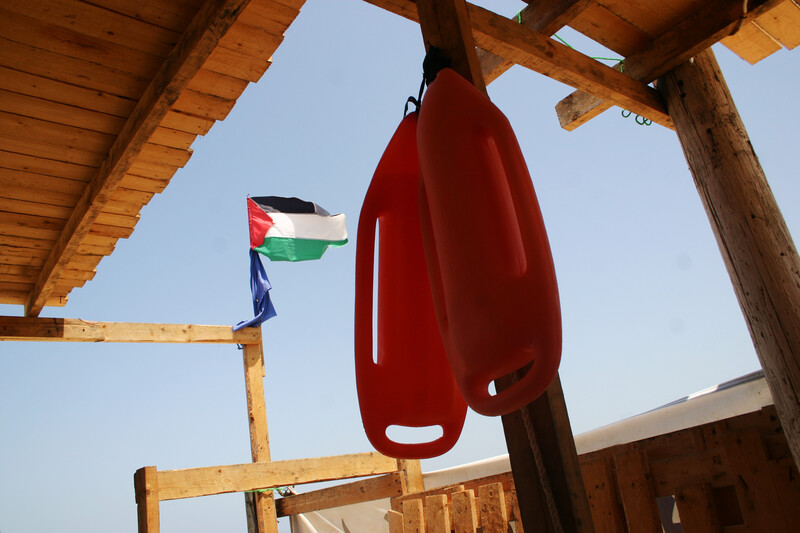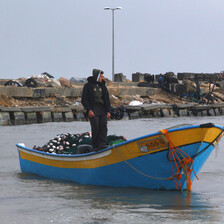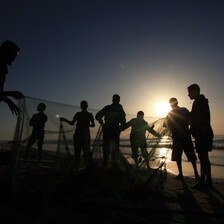The Electronic Intifada Gaza Strip 19 August 2011

Basic rescue floats are among the few items of equipment available to Gaza’s lifeguards.
IPSSHEIK RAJLEEN (IPS) - It’s a sunny Gaza morning and although a work day, the beach along Sheik Rajleen has enough people on it to keep Gaza’s small number of lifeguards busy and alert. From a simple, raised wooden hut, a team of three monitor the sea, periodically calling out to swimmers below to move to calmer waters.
“I’ve known how to swim since I knew how to walk,” says Ahmed el Basha, one of Sheik Rajleen’s lifeguards.
“I’m a fisherman, my father is a fisherman, and my grandfather was a fisherman. Most of the lifeguards in Gaza are from fishing families, so they know how to swim well. But we also take training courses in first aid and in sea rescue from the Civil Defense.”
In the Gaza Strip, under siege since early 2006 after Hamas was democratically elected, the sea is one of few options for recreation and relaxation. It also offers a means of cooling down when the Strip endures its daily power cuts.
“Most people don’t have the chance to take swimming lessons here. If they had money, they could learn, but most don’t have enough money to feed their families, let alone spend on swimming lessons,” says Basha.
This, says Abu Assam Masharawi, another lifeguard at Basha’s station, is the main cause of swimming accidents in Gaza.
“When we see people who obviously can’t swim, we call them in close to the shore. No one has drowned this year during life guard hours.”
Swimming after hours
However, there have been at least three drowning incidents in the Gaza Strip this year.
“The danger is swimming after hours. Some people prefer to swim at night, like women who come together to swim when men aren’t around, or people who swim after work,” says Masharawi.
“We tell people not to swim after lifeguard hours, but not everyone listens,” says Abu Nidal at a lifeguard station a few hundred meters south along the Sheik Rajleen beach.
“Last night, after 9 pm when lifeguards were off-duty, a man went out too far. He didn’t know how to swim and he drowned.”
Aside from public safety awareness, the greatest obstacles Gaza’s lifeguards face are caused by Israel.
Oxygen tanks banned by Israel
“I’m trained in scuba diving,” says Masharawi. “But we don’t have oxygen tanks, they are forbidden by the Israelis for security reasons, under the Oslo accords. We didn’t have rescue equipment either. But I designed some based on one an American friend brought me. Now we have these basic rescue floats, at least.”
As with every aspect of life in the Strip, the regular power cuts affect the lifeguards’ work.
“Our megaphones don’t work when the power cuts, and we can’t shout loud enough to warn people swimming to come in if we feel they’re in danger,” he says as another lifeguard blasts on a plastic whistle and gestures with waving arms for swimmers to move southward away from higher waves.
The fact that the lifeguards even have the microphones in the first place is due to the tunnels from Egypt.
“The microphone normally costs 500 shekels ($140) but because we had to bring it through the tunnels, we paid 1,300 shekels ($360),” notes Abu Nidal.
“We don’t have jet-skis, which would allow us to reach people in trouble quickly. We are forbidden from having jet-skis under the Oslo accords,” says Masharawi.
“We have a motorboat but only have enough fuel to run it on Fridays, when the beach is busiest,” he says. “Anyway, one boat for three kilometers isn’t enough. If we need to reach a victim two kilometers from where the boat is, there might not be enough time.”
Relying on volunteers
The latter is a problem of funding, says Masharawi. The insufficient number of trained lifeguards along Sheik Rajleen is also the result of inadequate finances. Although he refers to the municipality of Sheik Rajleen, Masharawi’s comments apply to the different municipalities along the coast, all facing similar constraints under the siege.
“In the Sheik Rajleen beach region, about three kilometers, there are 10 lifeguard stations, which is a good ratio,” he explains. “But we don’t have enough lifeguards at each station. We need more support: funding and training, it’s been cut under the siege on Gaza. Many of our lifeguards are volunteers.”
But despite the many siege-related obstacles, Masharawi and his colleagues love their work.
“I once saved four people who had swum too far out. Then I realized there was a fifth further out who had gone under. Thanks to God, I was able to fish him out and he was fine,” says Masharawi.
As with Gaza’s medics and Civil Defense, most take pride in their work, humanitarian work which is rendered difficult by the impossible situation of Gaza under siege and regular Israeli attacks.
“Lifeguarding is work for our community and work for God. I love it and feel it is my duty,” says Masharawi. “The sea is one of the only places people in Gaza can relax. It needs to be a safe place.”
All rights reserved, IPS - Inter Press Service (2011). Total or partial publication, retransmission or sale forbidden.



